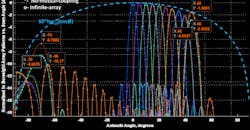Analysis of a 24- to 30-GHz Phased Array for 5G Applications (Part 2) (.PDF Download)
Here, we’ll begin by exploring full-wave simulation of the 5-×-16 array shown in Figure 1 of Part 1. The last resort is a numerical simulation of the entire array using commercial 3D full-wave software, such as CST Microwave Studio (MWS), ANSYS HFSS, COMSOL Multiphysics, EMPIRE XPU, etc. All data can also be obtained via testing inside the antenna range. Thus, we can generate an embedded database of 3D patterns and scattering (S) or impedance (Z/Y) matrices for each element in the array.
This approach leads to an outcome with a massive database (see footnote 1 from Part 1) and assumes access to high-performance computers. It’s desirable to implement parallel processing, as well as GPU and cache accelerating.6 All of the numerical simulation data that follows was obtained using CST MWS.
